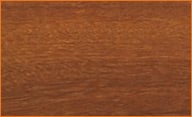(teca brasileña, almendrillo, tonka, tonquin bean)
Cumarú |
|
PHOTO
|
 |
| DESCRIPTION | Color varies from a golden tan to a reddish brown with some dark grain accents through out the wood. |
| COUNTRY OF ORIGIN |
South America (Brazil) |
| BOTANICAL NAME | Dipteryx Odorata |
| OTHER NAMES | Almendrillo, Brazilian Teak, Tonka, and Tonquin Bean |
| MECHANICAL PROPERTIES | This wood has a bending strength of 14,793 psi. |
| WORKING PROPERTIES | Difficult to saw and bore. Where severely interlocked grain is not present, the wood planes to a smooth surface. Because of its high density and oily nature, the wood glues poorly. It nails and screws well; pre-boring is necessary. |
| DURABILITY | Cumaru is very durable. The heartwood has shown to be very durable in resistance to both brown-rot and white rot fungi. The wood has excellent weathering characteristics. |
| SEASONING | Cumaru is rated as easy to air-season with a slight tendency to check and with moderate warping; drying was uniformly rapid. |
| USES | Outdoor Decking, flooring, cogs and shafts, heavy construction, barge and dock fenders, railroad crossties, pulp mill equipment, tool handles, bearings, turnery. A substitute for lignum vitae. |
| COMMENTS | The cumaru tree is cultivated in many areas for the tonka beans used as a flavoring, which have a vanilla-like flavor. |
No comments:
Post a Comment